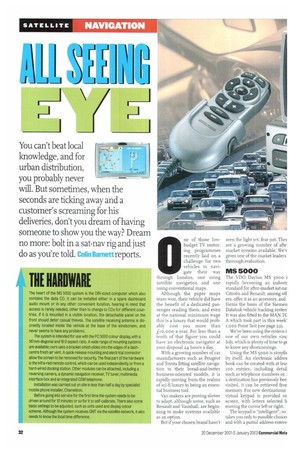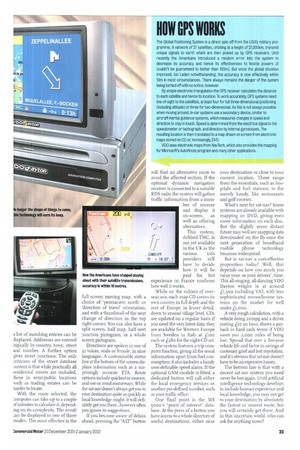ga SEUL
Page 32

Page 33

If you've noticed an error in this article please click here to report it so we can fix it.
You can't beat local knowledge, and for urban distribution,
you probably never MEM= will. But sometimes, when the seconds are ticking away and a customer's screaming for his deliveries, don't you dream of having someone to show you the way? Dream no more: bolt in a sat-nay rig and just do as you're told. Colin Barnett reports. One of those lowbudget TV motoring programmes recently laid on a challenge for two vehicles to navigate their way through London, one using satellite navigation and one using conventional maps.
Although the paper maps team won, their vehicle did have the benefit of a dedicated passenger reading them, and even at the national minimum wage this is a luxury that would probably cost you more than Do,000 a year. For less than a tenth of that figure you could have an electronic navigator at your disposal 2.4 hours a day.
With a growing number of car manufacturers such as Peugeot and Toyota fitting satellite navigation to their bread-and-butter business-oriented models, it is rapidly moving from the realms of sci-fi luxury to being an essential business tool.
Van makers are proving slower to adapt, although some, such as Renault and Vauxhall, are beginning to make systems available as an option.
But if your chosen brand hasn't
seen the light yet, fear not. Ther are a growing number of afte: market systems available. We'v given one of the market leaders thorough evaluation.
MS 5000
The VDO Dayton MS 5000 rapidly becoming an industr standard for after-market sat-na Citroen and Renault, among oft ers, offer it as an accessory, and forms the basis of the Siemen Datatrak vehicle tracking systen It was also fitted to the MAN TC A which took part in this week' Leo() Point Test (see page 22).
We've been using the system i one of our own vehicles sinc July, which is plenty of time to gE to know any shortcomings.
Using the MS 50= is simplic ity itself. An electronic addres book can be created with at leaE Jao entries, including detail such as telephone numbers or, a destination has previously bee: visited, it can be retrieved fror memory. For new destinations virtual keypad is provided or screen, with letters selected b moving the cursor left or right.
The keypad is "intelligent", so : takes you only to possible choice: and with a partial address entere. a list of matching entries can be iisplayed. Addresses are entered Logically by country, town, street and number. A further option gives street junctions. The only :riticisrn of the street database :ontent is that while practically all residential streets are included, those in semi-public locations such as trading estates can be harder to locate.
With the route selected, the :omputer can take up to a couple Df minutes to calculate it, dependLng on its complexity. The result :an be displayed in one of three modes. The most effective is the
full screen moving map, with a choice of 'permanent north' or 'direction of travel' orientation, and with a thumbnail of the next change of direction in the top right corner. You can also have a split screen, half map, half next junction pictogram. or a whole screen pictogram.
Directions are spoken in one of 21 voices, male or female, in nine languages. A customisable status line at the bottom of the screen displays information such as a surprisingly accurate ETA. Route options include quickest or nearest, and use or avoid motorways. While the sat-nay doesn't always get you to your destination quite as quickly as local knowledge might, it will definitely gel you there.. however often you ignore its suggestions.
If you become aware of delays ahead, pressing the "ALT" button
will find an alternative route to avoid the affected section. If the optional dynamic navigation receiver is connected to a suitable RDS radio the system will gather traffic information from a number of sources and display it
on-screen, as well as offering alternatives.
This system, dubbed TMC, is not yet available in the UK as the various info providers still have to decide how it will be
paid for, but experience in France confirms how well it works.
While on the subject of overseas use, each map CD covers its own country in full depth and the rest of Europe in lesser detail, down to around village level, CDs are updated on a regular basis if you need the very latest data; they are available for Western Europe from Sweden to Italy at iroo each or izSo for the eight-CD set.
The system features a trip computer function, giving all the usual information apart from fuel consumption; it also indudes a handy user-definable speed alarm. If the optional GSM module is fitted, a dedicated button will call either the local emergency services or another pre-defined number, such as your traffic office.
One final point is the MS 5000's "point of interest" database. At the press of a button you have access to a whole directory of useful destinations, either near
your destination or close to your current location. These range from the essentials, such as hospitals and fuel stations; to the merely handy, like restaurants and golf courses.
What's next for sat-nay? Some systems are already available with mapping on DVD, giving even more information on each disc. But the slightly more distant future may well see mapping data downloaded on the fly once the next generation of broadband mobile phone technology becomes widespread.
But is sat-nay a cost-effective proposition today? Well, that depends on how you much you value your, or your drivers', time. This all-singing, all-dancing VDO Dayton weighs in at around LI,5(Do including VAT, with less sophisticated monochrome systems on the market for well under fr,000.
A very rough calculation, with a vehicle doing zompg and a driver costing Do an hour, shows a payback in hard cash terms if VDO saves you 2,000 miles of being lost. Spread that over a five-year vehicle life and factor in savings of customer grief and lost reputation, and it's obvious that sat-nay doesn't have to be an expensive luxury.
The bottom line is that with a decent sat-nay system you need never be lost again. Until artificial intelligence technology develops to include human experience and local knowledge, you may not get to your destination by absolutely the fastest or nearest route, but you will certainly get there. And in this uncertain world, who can ask for anything more?




























































































































































